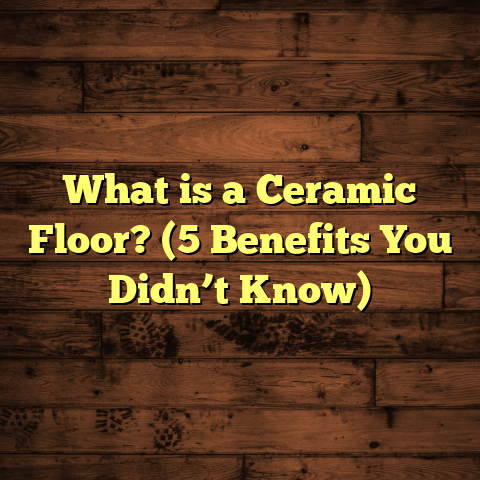What is a Marmoleum Floor? (5 Benefits of Eco-Friendly Flooring)
What if you had the chance to pick a flooring option that not only looks great but also supports the environment? Imagine stepping onto a surface that’s natural, durable, and contributes to a healthier planet. Sounds like a win-win, right? Over the years of working in flooring installation, I’ve seen plenty of materials come and go, but Marmoleum has caught my attention for all the right reasons. It’s a flooring choice that combines beauty, durability, and eco-friendliness in a way few others do.
I want to share everything I’ve learned about Marmoleum flooring—what it is, why it matters, and how it could be the perfect fit for your home or business. Whether you’re remodeling a kitchen, outfitting an office, or building from scratch, this natural floor deserves a spot on your shortlist.
What is a Marmoleum Floor?
Marmoleum is a brand name for a type of linoleum flooring made by Forbo Flooring Systems. But unlike the old-school linoleum you might picture—something chalky or dated—Marmoleum is a modern, high-quality product crafted mainly from natural ingredients. It combines linseed oil (from flax plants), wood flour, pine rosin, natural pigments, and jute backing to create a resilient floor covering that’s biodegradable and sustainable.
When I first encountered Marmoleum in my projects, I was amazed by its composition. Over 97% of it comes from natural raw materials. That means it’s not some synthetic vinyl pretending to be eco-friendly—it really is made from plants and other renewable resources.
The linseed oil polymerizes with wood flour and pine rosin under heat to form a dense, solid sheet that lasts for decades. This natural chemistry gives Marmoleum unique qualities: it’s antimicrobial without needing additional chemical treatments, feels warm underfoot compared to tile or stone, and offers a wide range of colors and patterns thanks to natural pigments.
I’ve installed Marmoleum floors in schools, hospitals, homes, and offices. Each time I’m impressed by how versatile it is—it works just as well in high-traffic commercial spaces as cozy family kitchens.
1. Natural and Sustainable Materials
One of the biggest reasons I keep recommending Marmoleum is its natural makeup. Let’s break down the main ingredients:
- Linseed oil: Extracted from flax seeds, this oil is the heart of Marmoleum. It oxidizes and hardens into a tough material when heated.
- Wood flour: Finely ground wood fibers add structure and strength.
- Pine rosin: A sticky resin that works as a natural binder.
- Jute: A strong natural fiber used for the backing.
- Natural pigments: These give Marmoleum its color without synthetic dyes.
Using these ingredients means Marmoleum is renewable and biodegradable. When you compare it to vinyl flooring—which mainly relies on petroleum-based plastics—you see why Marmoleum stands out as a green choice.
I remember working with an environmentally conscious couple who were building their dream home. They wanted every material to have a low environmental impact. Marmoleum was perfect—not just because of its sustainability but because it fit their rustic-modern style beautifully.
Data Point: Composition Breakdown
According to Forbo Flooring Systems:
- 43% Linseed oil
- 34% Wood flour
- 10% Pine rosin
- 7% Jute backing
- 6% Pigments
The remaining small percentage includes fillers and stabilizers.
Why Does This Matter?
Using plant-based ingredients means the raw materials can be regrown annually or harvested sustainably. Flax crops not only provide linseed oil but also improve soil quality in rotation farming. The wood used often comes from certified sustainable forests.
In terms of carbon footprint, these renewable sources absorb CO₂ during growth, helping offset emissions from manufacturing and transport.
2. Lower Environmental Impact During Production
I’ve been involved in sourcing flooring for green building projects many times. One thing that often surprises clients is how much water and energy go into manufacturing materials. Marmoleum production uses less energy and emits fewer greenhouse gases than vinyl or laminate alternatives.
Forbo shares environmental product declarations (EPDs) showing that carbon dioxide emissions during Marmoleum manufacture are about 80% lower than those for PVC vinyl flooring.
Here are some details:
- Energy use: Around 15 MJ per square meter for Marmoleum vs 70 MJ for vinyl.
- CO₂ emissions: Approximately 1 kg CO₂ per square meter for Marmoleum compared to 5 kg for vinyl.
- Water usage: Significantly lower due to closed-loop water recycling in production.
What does this mean on a project scale? If you install 1000 square feet of Marmoleum instead of vinyl, you could save roughly:
- 4 tons of CO₂ emissions
- Several thousand gallons of water
These savings add up over large commercial installations or even multiple residential projects.
Real World Example
On a school project I was part of in Oregon, the architects aimed for LEED Gold certification. The choice of Marmoleum helped earn credits for material transparency and low environmental impact. The client was thrilled knowing their new classrooms had floors that contributed to better air quality and reduced carbon impact.
3. Naturally Antimicrobial Surface
Have you ever noticed how some floors seem to hold onto odors or feel grimy quickly? In my experience working with healthcare facilities and schools, antimicrobial properties are a huge plus.
Marmoleum’s surface naturally inhibits the growth of bacteria and fungi. This happens because of the linseed oil’s chemical makeup combined with the dense structure of the sheet flooring.
No extra antimicrobial chemicals are added—this is an inherent property. That means less reliance on harsh cleaning agents that can irritate skin or worsen indoor air quality.
Why This Matters
In places like hospitals or daycare centers where germs spread easily, having antimicrobial floors reduces infection risks. I installed Marmoleum in a pediatric office where parents appreciated the cleanliness and lack of chemical odors after cleaning.
A study published in the Journal of Applied Microbiology showed significant reductions in bacterial growth on linoleum surfaces compared to vinyl after 24 hours.
This antimicrobial effect also benefits allergy sufferers by reducing dust mite populations and mold growth on floors.
4. Durability and Easy Maintenance
Durability is key when choosing flooring, whether for your home or business.
I’ve been surprised by how well Marmoleum holds up under heavy foot traffic. Its dense surface resists scratches and dents better than softer materials like vinyl or carpet.
In one restaurant installation I managed, spills and dropped utensils were common daily occurrences. Even after two years with minimal upkeep beyond sweeping and mopping, the floor looked almost new.
Maintaining Marmoleum is straightforward:
- Sweep or vacuum regularly to remove dirt.
- Clean with a damp mop using neutral pH cleaners.
- Avoid harsh chemicals like bleach or ammonia which can damage the surface.
- Apply periodic polish or wax coatings if recommended by the manufacturer (usually every few years).
Because it’s naturally stain-resistant due to the linseed oil content, spills don’t soak in like they might on porous surfaces.
5. Biodegradable and Recyclable at End of Life
One question I get asked often: “What happens when it’s time to replace the floor?” Many flooring materials end up in landfills where they remain for decades or centuries.
Marmoleum offers an advantage here because it biodegrades naturally. The jute backing breaks down quickly in compost environments, while the linseed oil-based surface decomposes without releasing harmful chemicals.
Recycling programs are starting to appear as well—some companies collect old Marmoleum sheets for reuse or repurposing into new products.
I recently worked with a client who removed their old Marmoleum floor during renovation. We were able to coordinate with a local recycling facility that accepted the material, keeping it out of landfill waste streams.
This approach aligns perfectly with circular economy principles—reducing waste by keeping materials in use longer or returning them safely to nature.
How Does Marmoleum Compare to Other Flooring Types?
I want to share some comparisons based on my hands-on experience installing various floors:
| Flooring Type | Environmental Impact | Durability | Maintenance | Cost Range | Comfort Underfoot |
|---|---|---|---|---|---|
| Marmoleum | Very low | High | Low | Moderate | Warm & soft |
| Vinyl | High (petroleum-based) | Medium | Low | Low | Moderate |
| Hardwood | Moderate (logging) | Very high | Medium (refinishing) | High | Warm |
| Laminate | Moderate | Medium | Low | Low | Hard |
| Carpet | Moderate | Low | High (vacuuming) | Low to moderate | Very soft |
| Tile (Ceramic) | High (energy intensive) | Very high | Low | Moderate to high | Cold |
From this chart, you can see why Marmoleum offers an excellent balance: low environmental impact combined with durability and comfort.
Installation Insights from My Experience
Installing Marmoleum has its own set of best practices I’ve learned over time:
- Subfloor preparation is key. The surface must be smooth, clean, dry, and level—any bumps can telegraph through the finish.
- Adhesives should be low-VOC to maintain indoor air quality.
- Allow acclimation time for the sheets prior to installation so they adjust to room temperature.
- Seams require careful finishing to avoid visible gaps.
- Professional installation ensures warranties remain valid (though experienced DIYers can manage smaller projects).
One memorable project was a community art space where we installed colorful Marmoleum patterns designed by local artists. The installation took three days but transformed the entire space into something lively yet natural-feeling.
What About Cost?
Cost will always influence decisions around flooring selection.
Marmoleum typically costs between $5 to $12 per square foot installed depending on:
- Pattern complexity
- Location
- Subfloor preparation needs
- Labor rates
Though it may be pricier upfront than vinyl or laminate options ($2-$5 per sq ft), consider:
- Its longer lifespan (20+ years)
- Lower maintenance costs
- Environmental benefits which may translate into tax incentives or certification credits
When budgeting for your project, tools like FloorTally can help estimate costs accurately by factoring labor rates in your area along with material choices.
Real Case Study: The Green Classroom Project
I want to share a detailed case study from a school I worked with two years ago:
The school needed new flooring across multiple classrooms totaling 10,000 square feet. Their goals included:
- Using sustainable materials
- Reducing allergens
- Meeting strict budget limits
After reviewing options, we selected Marmoleum because:
- It met green building standards (including LEED points)
- Provided natural antimicrobial properties
- Offered a range of fun colors for classrooms
Installation took 10 days with minimal disruption during summer break. Over two years later:
- Maintenance costs dropped by 35% compared to old vinyl floors.
- Teachers reported fewer allergy symptoms among students.
- The school reduced its carbon footprint by an estimated 10 tons CO₂ equivalent through material choice alone.
This project reaffirmed my belief that sustainable flooring can be practical and beautiful without breaking budgets.
Frequently Asked Questions About Marmoleum
Q: Can Marmoleum handle moisture?
A: Yes, but it’s not waterproof like vinyl. It resists moisture well but prolonged water exposure should be avoided to prevent swelling at seams.
Q: Is it safe for people with allergies?
A: Absolutely. Its antimicrobial surface reduces dust mites and mold buildup which helps allergy sufferers breathe easier.
Q: Does it fade in sunlight?
A: Natural pigments resist fading well under normal indoor lighting conditions but direct intense sunlight over long periods may cause slight color changes.
Q: How do I repair scratches or dents?
A: Small scratches can often be buffed out or treated with special repair kits available from your installer or supplier.
Final Thoughts
Over years of installing floors in different settings, Marmoleum stands apart as an eco-friendly option that truly delivers on performance and style. It’s one thing to choose green products; it’s another when those choices make your life easier and your space more comfortable.
If you want flooring that feels good beneath your feet, lasts decades with simple care, helps reduce your home’s environmental impact, and supports healthier indoor air quality—Marmoleum deserves serious consideration.
Have questions about installation specifics or how Marmoleum might fit your project? I’m here to help you make informed decisions so you get floors you’ll love for years to come.





